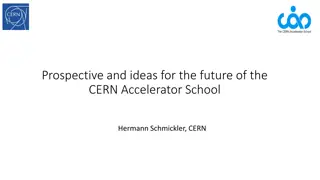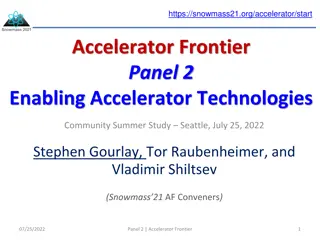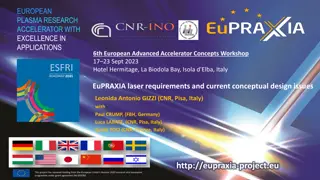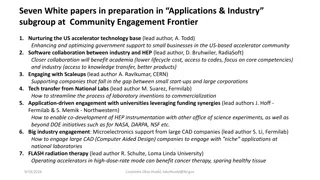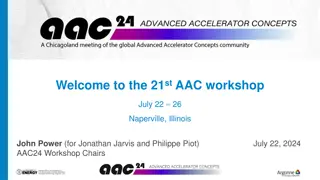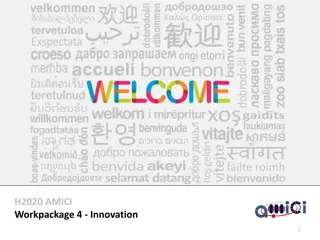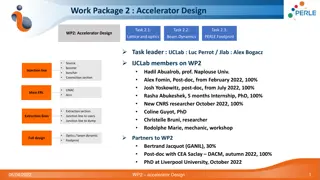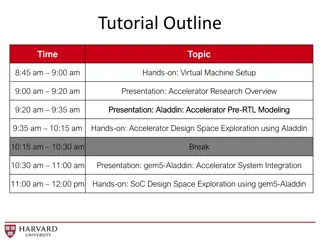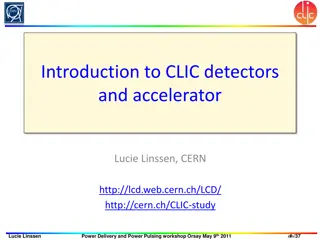Accelerator R&D for High-Energy Physics: Advancements and Future Prospects
Vladimir Shiltsev's presentation at DPF-PHENO 2024 discusses the evolution of accelerator R&D in high-energy physics, emphasizing the need for off-shore Higgs factories and targeted collider developments. The P5 recommendations underscore the importance of engaging in feasibility studies for advanced collider technologies to unlock the mysteries of particles like the Higgs boson. The presentation highlights current accelerator R&D initiatives in the US and proposes substantial investments for future advancements, emphasizing collaborations and innovation to drive progress in the field.
- Accelerator R&D
- High-Energy Physics
- Collider Development
- Particle Accelerators
- Advanced Technologies
Download Presentation

Please find below an Image/Link to download the presentation.
The content on the website is provided AS IS for your information and personal use only. It may not be sold, licensed, or shared on other websites without obtaining consent from the author. Download presentation by click this link. If you encounter any issues during the download, it is possible that the publisher has removed the file from their server.
E N D
Presentation Transcript
Accelerator R&D for HEP: The Next Decade and Beyond Vladimir SHILTSEV DPF-PHENO 2024 May 14, 2024 U. Pittsburgh & Carnegie Mellon U.
Acknowledgements Kathleen Amm Mei Bai Sergey Belomestnykh Steve Gourlay Michiko Minty Mark Palmer Sam Posen Pantaleo Raimondi Tor Raubenheimer Thomas Roser Diktys Stratakis Sasha Valishev Frank Zimmermann, et al. Snowmass 21: Accelerator Frontier WPs Accelerator Frontier Report Snowmass 21 Summary Report P5 Report 2 Vladimir SHILTSEV
Thomas Roser et al 2023 JINST18 P05018 Vladimir SHILTSEV 3
P5 Recommendations Recommendation 2c: An off-shore Higgs factory, realized in collaboration with international partners, in order to reveal the secrets of the Higgs boson. The current designs of FCC-ee and ILC meet our scientific requirements. The US should actively engage in feasibility and design studies. [ ] Recommendation 4a: Support vigorous R&D toward a cost-effective 10 TeV pCM collider based on proton, muon, or possible wakefield technologies, including an evaluation of options for US siting of such a machine, with a goal of being ready to build major test facilities and demonstrator facilities within the next 10 years [ ] Wakefield concepts for a collider are in the early stages of development. A critical next step is the delivery of an end-to-end design concept, including cost scales, with self-consistent parameters throughout. This will provide an important yardstick against which to measure progress with this emerging technology path. 4 Vladimir SHILTSEV
P5 Area Recommendations Now (FY23 $) P5 recomm. General Accelerator R&D * ~50M$/yr +10 M$/yr ~ 1B$ combined over the next decade Targeted Collider R&D 0 M$/yr +35 M$/yr FNAL Accel.Complex Plan 0 M$/yr +10 M$/yr * Note: in addition, Accelerator Test Facilities are supported at ~40M$/yr these are of great relevance for R&D and projects (eg tests and pre-project R&D) Vladimir SHILTSEV 5
Accelerator R&D in the US General Accelerator R&D (GARD, OHEP program): Supports ~30 university grants and 7 DOE national labs Advanced Accelerator Concepts Superconducting Magnets and Materials RF Accelerator Technology (NC and SC) Accelerator and Beam Physics Particle Sources and Targets Very successful in the past: Nb3Sn magnets LARP HL-LHC, etc Of relevance are (smaller) programs/support from other offices: NP, BES, FES, ASCR, NSF Targeted Accelerator R&D (to be org d, see May 24 HEPAP mtg) More focused; certain timeline used to exist (ILC, LARP, MAP) 6 Vladimir SHILTSEV
Scale & Timeline for HEP colliders International Linear Collider (ILC) ILC250 FCC-hh FCC-ee 10 km e+e- linear collider with Superconducting RF linac Baseline: s = 500 GeV (31 km) upgrade later to ~ s= 1 TeV (50 km), luminosity of 1.8 1034 cm-2 s-1 with optional upgrade, one interaction point (IP) with two detectors: ILD and SiD with push-pull CEPC FCC-ee Overview of Future Colliders, H. Zhu ILC Muon Collider FCC-hh 4 Institute of High Energy Physics 2040 2050 2060 2070 Possible years to start collider operation according to proponents 7 Vladimir SHILTSEV
Damping Ring Interaction point ILC e+ Source e- Main Linac e- Source Beam dump Physics Detectors International Linear Collider (ILC) is an ?+? machine based on superconducting RF linac technology e+ Main Liinac Accelerating gradient 31.5 MV/m (ave.) at ?0= 1010 ~8,000 9-cell cavities in ~900 cryomodules Shovel-ready design: TDR (2013) still no host Energy is upgradeable with conventional Nb SRF technology to 500 GeV and to 1 TeV (45 MV/m, ?0= 2 1010) or with advanced SRF (traveling wave or Nb3Sn) The first SRF cryomodule (full ILC specifications) operation with beam was demonstrated at FAST (Fermilab) in 2018; followed by a KEK test in 2021 * * AC plug-power may be further reduced (10 ~ 20 %), if the RF (Klystron) and SRF/Cryogenics (Q-value) Efficiency may be improved. Vladimir SHILTSEV 8
ILC Remaining R&D Topics While the ILC is at TDR ( shovel-ready ) since 2013, some R&D is still ongoing to demonstrate beam parameters (nano-beams in ATF2 at KEK), further improve performance and demonstrate industrialization of the SRF linac, develop alternative concepts (e-linac-based positron source) SRF technology Nano-beam technology (damping ring and final focus) Positron source pre-accelerator few GeV source Nano-Beam Technology KeV damping ring few GeV extraction & dump SRF Technology few GeV 250-500 GeV final focus IP bunch compressor main linac collimation Vladimir SHILTSEV 9
FCC-ee Stage 1 of the Future Circular Collider (FCC): an ?+? Higgs factory, electroweak & top factory operating at highest luminosities (?,?,?,? ?) Parameter Z WW H (ZH) ttbar 45.6 80 120 182.5 beam energy [GeV] Limited by 100 MW of synchrotron radiation (2 beams) 1270 137 26.7 4.9 beam current [mA] 11200 1780 440 60 number bunches/beam 2.14 1.45 1.15 1.55 bunch intensity [1011] Two 90.7 km rings and booster in the same tunnel 0.0394 0.374 1.89 10.4 SR energy loss / turn [GeV] CDR (2018), Feasibility Study (2021- Mar 2025) 0.120/0 1.0/0 2.1/0 2.1/9.4 total RF voltage 400/800 MHz [GV] 1158 215 64 18 long. damping time [turns] Start operation in ~2045 0.11 0.2 0.24 1.0 horizontal beta* [m] 0.7 1.0 1.0 1.6 vertical beta* [mm] 0.71 2.17 0.71 1.59 horizontal geometric emittance [nm] 1.9 2.2 1.4 1.6 vertical geom. emittance [pm] 9 21 13 40 horizontal rms IP spot size [ m] 36 47 40 51 vertical rms IP spot size [nm] 0.002/0.0973 0.013/0.128 0.010/0.088 0.073/0.134 beam-beam parameter x / y 5.6 / 15.5 3.5 / 5.4 3.4 / 4.7 1.8 / 2.2 rms bunch length with SR / BS [mm] 140 20 5.0 1.25 luminosity per IP [1034 cm-2s-1] 17 2.4 0.6 0.15 total integrated luminosity / IP / year [ab-1/yr] 15 12 12 11 beam lifetime rad Bhabha + BS [min] *Site AC power is 290 MW at CM energy 240 GeV Vladimir SHILTSEV 10
US-FCC Plan (2023) Proposed scope - RF Systems 1) 800 MHz SRF for Booster and Collider (28 CMs 244 CMs) 2) 800 MHz RF power sources (klystrons >80% eff.) 3) RF for 6-20 GeV e+/e- injector linac (C3 tech.) Proposed scope - Magnets Systems 1) IR magnets and cryostats (for 4 IRs) 2) Collider ring and Booster ring magnets (low field) 3) FCC-hh collider ring magnets (14-20 T) Proposed scope Optics/Design/Instr. 1) Interaction region design, and integrated machine design 2) Polarization (simul., wigglers, etc) 3) Beam Instrumentation (BPMs, feedback, etc) 11 ? ? Vladimir SHILTSEV
FCC-hh: Key Issues Stage 2 of the Future Circular Collider: ~100 TeV, a natural continuation at energy frontier with ?? collisions and ? option With FCC-hh after FCC-ee there will give significantly more time for high-field magnet R&D aiming at highest possible energies Start operation in ~2070 parameter FCC-hh collision energy cms [TeV] 81 - 115 dipole field [T] 14 - 20 circumference [km] 90.7 arc length [km] 76.9 High-field superconducting magnets: 14 - 20 T: The magnet technology will determine the energy reach of the machine (current record 14.5T) Power load on cold vacuum chamber in arcs from synchrotron radiation: 4 MW (~103times higher than LHC) cryogenics, vacuum Stored beam energy: ~ 9 GJ (~10 times of HL-LHC) machine protection Pile-up in the detectors: ~1000 events/crossing R&D to reduce cost (ITF: 30-50 B$ no esc., no cont.) and energy consumption (4 TWh/year) cryogenics, HTS, beam current, Synergy with SppC in China beam current [A] 0.5 bunch intensity [1011] 1 bunch spacing [ns] 25 synchr. rad. power / ring [kW] 1020 - 4250 SR power / length [W/m/ap.] 13 - 54 long. emit. damping time [h] 0.77 0.26 peak luminosity [1034 cm-2s-1] ~30 events/bunch crossing ~1000 stored energy/beam [GJ] 6.1 - 8.9 Integrated luminosity/main IP [fb-1] 20000 *Estimated operating AC power is ~560 MW Vladimir SHILTSEV 12
=?+????????? 4??? ?? Muon Collider ???? 150 ? 1600 turns Tentative parameters based on U.S. Muon Accelerator Program studies Muon collider combines precision and energy reach needed to test the deepest questions of particle physics x(4-7) smaller footprint than pp-collider for the same pCM energy Muons are 207 times heavier than electrons and are not limited by synchrotron radiation and beamstrahlung energy efficiency BUT muons decay (2.2 s lifetime at rest), hence many issues 4-6 years to design of demonstration facility muon beam R&D (10-20)x MICE at RAL (2020) Schematic layout of a 10-TeV muon collider complex The muon collider concept was developed by NFMCC in 1990s-2000s and by the U.S. MAP (2011-2016) In 2022 International Muon Collider Collaboration (IMCC) was formed, hosted by CERN Nature Physics | VOL 17 | March 2021 | 289 292 | www.nature.com/naturephysics Vladimir SHILTSEV Aug.2024: inaugural US-MCC Meeting (at Fermilab) * 13
Collider Challenges and R&D Topics P5 priority: by ~2028 prepare a CDR of the 10 TeV+ pCMColliderand TDRof a Demonstrator Facility! R&D focus on: Feasibility of Energy Reach Fast magnets for the accelerator rings (~few ms, ~20 km) Economical high-gradient pulsed SRF (~few ms, ~20-40 GeV) Collider ring 12-16 T superconducting magnets (DC, ~10 km) Feasibility of Luminosity Goals Proton driver: 1-4 MW at 5-20 GeV; accumulate bunches with up to 1014 particle, compress to few ns; deliver at 5-10 Hz rate Targets and cooling: DPAs, ~15 T SC solenoid with ~2 m aperture; high-gradient NC RF in 2-14 T SC solenoids of the ionization cooling channel (these are also prerequisites for the Demonstrator Facility see next slides) Challenging MDI to suppress breakdown originating from muon decays; neutrino flux dilution scheme Feasibility of Construction Cost Fast magnets for the accelerator rings (~few ms, ~20 km) Civil construction (~40 km) Economical high-gradient pulsed SRF (~few ms, ~20-40 GeV) Collider ring 12-16 T superconducting magnets (DC, ~10 km) Power infrastructure (~360 MW) Vladimir SHILTSEV 14
Normal Conducting Magnets Cost is set by the scale (energy, length, power) and technology ~50 10 % Accelerator technology (magnets NC and SC, RF and SCRF, vacuum, etc) Normal Conducting RF SC RF SC magnets Civil construction technology ~35 15 % Electric power production, delivery and distribution technology Vladimir SHILTSEV ~15 10 % 15
Muons Give Us A Unique Chance! (due to that factor of ~7 in equivalent pCM ) The smallest footprint for traditional core technologies less total cost for technology and tunnels (due to absence of synchrotron radiation multi-turn acceleration in rings, rather than one-time in linear colliders) The lowest power consumption: per ab-1and total among 10+ TeV pCM colliders All in all lowest cost + feasible/traditional technologies + fastest Snowmass 21 ITF estimates >10 yrs of pre-project R&D and 19-24 yrs to 1st physics after the start of the program (not started yet) just do it! = CDR the Demonstrator TDR Construction) 16 Vladimir SHILTSEV
Ionization Cooling Demonstrator https://doi.org/10.1140/epjc/s10052-023-11889-x MC ionization cooling channel consists of ~800 muon cooling cells The cooling of muons requires very compact assembly of normal conducting RF cavities, superconducting solenoids, and either liquid hydrogen or LiH absorbers Large bore solenoids: from 2 T (D=1 m) to 20+ T (D=0.05 m) RF cavities (300-800 MHz) must operate in multi-Tesla fields Wedge-shaped absorbers must and large muon beam intensities Schematic of the muon cooling demonstrator Muon energy, MeV Total length, m Total # of cells 6D emm. reduction Beam loss, % B_max, T 200 ~980 ~820 2-14 x 1/105 ~70% Full scale MC 200 48 24 0.5-7 x 1/2 4-6% Demonstrator Timeline: 2029-2034 Location: Fermilab or CERN Cost: 200-300 M$ Vladimir SHILTSEV 17
R&D Synergies for Future HEP Colliders Beam optics Collective effects MDI + collimation Machine efficiency RF power efficiency SRF systems Off-shore Higgs Factory Examples of synergies with U.S. projects and accelerators: EIC (a NP machine in the DOE lingo): MDI, SRF, beam polarization, collective effects PIP-II: SRF, proton driver LCLS-II: SRF LBNF: targetry SNS: proton driver FCC-ee and hh have many synergies with similar projects in China: CEPC and SppC ~100 TeV Hadron Collider 10 TeV Muon Collider High-field SC magnets Vladimir SHILTSEV 18
Hard Simple Question Why does it ( your accelerator R&D ) take so long? 1990 s: SLAC linac had 17 MV/m Now: XFEL has ~25 MV/m (ILC 31.5 MV/m) Muon collider R&D since 1990s Now: still no CDR 2000s: LHC 8 T NbTi SC magnets Now: still no 16 T magnets 2006: 1 GeV plasma acceleration stage Now : sill no demo of multistage No simple answer combination of: Our modern-day technologies are too far from industrial applications Chasing pCM dreams : 100 GeV 1 TeV 10 TeV 100 TeV PeV ?? Higher energy, higher luminosity, larger [size, cost, power, complexity] more [$$, people, time] for R&D Always limited budget more and more often - inadequate expertise: bigger scale + brain drain to other fields + beam physics abandoned at Universities (in the US) Vladimir SHILTSEV 19
US Accelerator S&T Workforce: DOE Office of Sciences, P5, EPP2024 recognize diminishing expertise in accelerators (design, projects and operation) in the US and increased demand: DESPITE several recent initiatives: Particle Accelerators for Science and Society and Workforce Training (2021); RENEW: Reaching a New Energy Sciences Workforce (2023); FAIR: Funding for Accelerated, Inclusive Research (2023); MIni-Workshop on Accelerator Scientist / Engineer Workforce of National Labs (2024) DESPITE there are several select institutes : Center for Advanced Studies of Accelerators, CASA (JLab/ODU); Cornell Laboratory for Accelerator-based ScienceS and Education, CLASSE, and the Center for Bright Beams (NSF); Center for Accelerator Science and Education, CASE, at Stony Brook University (HEP); MSU cryo-initiative collaboration between FRIB and MSU College of Engineering (NP); Virginia Innovative Traineeships in Accelerators, VITA (DOE) YET the AS&T workforce situation is actually worsening Barely enough to keep up with current projects and operations (NP, BES, HEP, ) Plus, the level of expertise required for the future HEP facilities/colliders is much higher 20 Vladimir SHILTSEV
The US HEP Community Must Act! Next big HEP facilities (Higgs Factories, 10+ TeV pCM colliders, etc) will not be off-the-shelf particle accelerators, they require numerous innovative breakthroughs over a range of beam physics topics and accelerator technologies over the next O(20 years) That requires the leading US universities to get intellectually involved: E.g. out of ~70 Universities represented at this meeting, only 6 have some elements of accelerator R&D (besides major National labs) Need more accelerator/beam physics faculty! ?????. ? ??. ??????? 4 min ???? ??????? 21 Vladimir SHILTSEV
Summary P5 recommended to actively engage in feasibility and design studies of two off-shore Higgs factories, ILC and FCC-ee Also, P5 recommended to support vigorous R&D toward a cost-effective 10 TeV pCM collider based on proton, muon, or possible wakefield technologies The collider designs are at different stages of maturity, but all require quite extensive R&D efforts covering a wide range of challenging topics from beam optics to MDI to beam polarization to positron production to muons ionization cooling, high-field SC magnet and RF technologies Any future collider will require very high AC power to operate, special attention should be given to R&D topics that would improve efficiency of various systems There are synergies between the colliders and with other projects and accelerators. Situation with the accelerator science and technology workforce is very worrisome, there are concerns whether the required challenging R&D for HEP colliders can be finished successfully in a reasonable time. Besides the $$ (OHEP prerogative), serious intellectual involvement of universities is critical. Vladimir SHILTSEV 22
Thanks for your attention! Thank you for your attention! Questions? 23 Vladimir SHILTSEV
Back Up Slides Not Covered: Plasma and other advanced methods. Are they really helpful for HEP? Thanks for your attention! What about China? The CEPC can get approval next year or about. Connections to other fields using accelerators? There s a lot with NP (EIC), FES (magnetic confinement setups), and BES (light sources and spallation neutron sources). How much AST research $$ available now? 24 Vladimir SHILTSEV
Thanks for your attention! These synergies once again emphasize importance of General Accelerator R&D 25 Vladimir SHILTSEV
Metal rod exploded by beam impact High Power Targetry R&D Multi-MW targets are needed for neutron spallation sources, accelerator neutrino beam facilities and muon colliders Currently: 1-1.5 MW targets exist (FNAL, SNS, ) Huge challenges above that level: Need to design a target capable of withstanding such an exceptionally high thermal shock Accelerator neutrino beam (T2K, CNGS, NuMI, SBN, LBNF) Neutron spallation source (ESS, SNS, CSNS) Muon collider (MAP, IMCC design) DPAs Thermal shock Proton beam energy Low (1-3 GeV) Wide range (8-400 GeV) Medium (5-20 GeV) Need to be explored: New materials (graphite, liquid lead, tungsten powder) New forms: wheels, rolling balls, fibers, etc Similar issues with horns, baffles, windows, etc Modeling and simulation tools Dedicated facilities for irradiation studies, pion yield measurements, target survivability/lifetime Proton beam bunch length Short (105-700 ns) Long (4.2-10.5 s) Extremely short (1-3 ns) Proton beam intensity per bunch Medium (???? ?.? ????) Medium ?.? ???? ?.? ???? High (???? ????) Repetition rate High (14-60 Hz) Low (0.4-2 Hz) Medium (5-15 Hz) Target material Liq. Hg, W, Liq. Li, etc. graphite TBD Vladimir SHILTSEV 26
Magnet Technology R&D FCC-hh & muon collider require beyond state-of-the-art magnet technology High field dipoles up to 17 T (and perhaps 20 24 T) Large aperture with fields up to 13 T (or more) High radiation environment o Radiation Damage o Heat deposition Manage stress (Very) fast ramping magnets Large aperture, high field solenoids (> 30 T) Large aperture interaction region quadrupoles Conductor ultimately determines magnet performance Six different technological superconductors Low Temperature Superconductors (LTS) o NbTi, Nb3Sn, MgB2 High Temperature Superconductors (HTS), also high field o Bi2Sr2CaCu2O8 (Bi-2212 or BSCCO), Bi2Sr2Ca2Cu3O10 (Bi-2223), rare-earth Ba2Cu3O7 (ReBCO) Plus, a new family of iron-based superconductors (IBS), not yet commercially available Vladimir SHILTSEV 27
RF Technology R&D Thrusts Three RF technology R&D thrusts Typical ILC cavity at T = 2 K Superconducting RF (SRF) technology will be used in all colliders that we discuss in this presentation. FCC-ee, ILC, and muon collider will have very large installations. Improving SRF cavity performance is critical. Increase ? reduce cryogenic load Improve ???? decrease accelerat or length High-gradient normal conducting RF incl. C3 technology and operating RF in high magnetic fields as part of the muon ionization cooling channel High-efficiency RF sources (FCC-ee, ILC) to reduce overall AC power consumption of the machine 2 ???????? (? ?) ?0 ????= ?/? is a geometric parameter From the decadal NC conducting RF structure and RF source 10-year roadmap (2017): RF source cost including modulators in $ per peak KW vs. efficiency for mature RF source technologies. Vladimir SHILTSEV 28

 undefined
undefined












